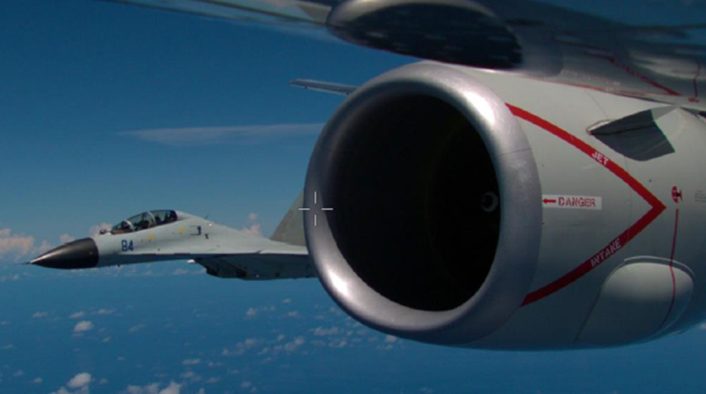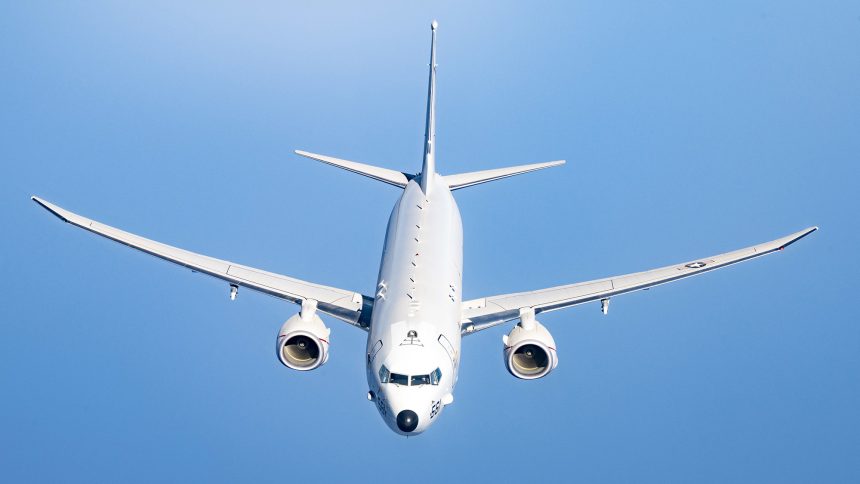Beijing dispatched naval, air forces to shadow a U.S. Navy P-8A Poseidon flying west of Taiwan.
China’s military announced on Nov. 26, 2024, that it had sent naval ships and aircraft to keep an eye on a U.S. Navy patrol plane cruising through the Taiwan Strait. According to Reuters, Beijing accused the U.S. of trying to “mislead” the global audience about the situation.
Every time, Beijing protests. China considers Taiwan part of its territory and insists it has authority over the strait. However, the U.S. and Taiwan disagree, saying the area is an international waterway. It’s not the first time this has happened. About once a month, U.S. military ships or aircraft make their way through the Taiwan Strait, the narrow waterway separating China from the self-governed island of Taiwan.
The latest incident involved a P-8A Poseidon, a maritime patrol plane, that flew through international airspace. The U.S. Navy’s 7th Fleet said the flight reflected their dedication to keeping the Indo-Pacific region “free and open.” The statement explained that by flying there, the U.S. was asserting navigational rights that every nation is entitled to under international law.
A U.S. Navy P-8A Poseidon transited the Taiwan Strait in international airspace on Nov. 26, 2024 (local time). By operating within the Taiwan Strait in accordance with international law, the United States upholds the navigational rights and freedoms of all nations. The aircraft’s transit of the Taiwan Strait demonstrates the United States’ commitment to a free and open Indo-Pacific. The United States military flies, sails and operates anywhere international law allows.
China, unsurprisingly, wasn’t happy, about the mission: they called the flight “public hype” and said their forces monitored the plane’s entire journey through the area, responding “effectively.” China’s Eastern Theatre Command also accused the U.S. of twisting the legal facts and trying to mislead public opinion, calling for Washington to stop stirring the pot and focus on maintaining regional peace.
Meanwhile, Taiwan’s defense ministry chimed in, saying their military had also been monitoring the flight and that everything was “normal.”
Interestingly, this isn’t the first time a U.S. Poseidon flight around China or Taiwan has caused a stir.
Very similar incidents occurred in April 2024, and on July, 13, 2023. Here’s an excerpt of the story we published about the latter.
[…] The aircraft, with its Mode-S transponder turned on could be tracked online via MLAT on Flightradar24.com as if flew in international airspace, more or less along the border between the Taipei FIR (Flight Information Region) and Shangai FIR.
It’s worth remembering here that the FIR does not match with sovereign airspace: the FIR is the portion of aerospace within which an ATC agency has responsibility for providing air traffic services; whereas sovereign airspace is the one over the territorial sea out to twelve nautical miles from the coastline.
Taiwan has also an ADIZ (Air Defense Identification Zone), created by the United States Armed Forces after World War II, that covers most of Taiwan Strait, part of East China Sea and adjacent airspace. As per other ADIZs around the world, this ADIZ, is not defined in any international treaty and is not regulated by any international body: it is mostly over international airspace (territorial airspace begins only 12 miles from the coastline), hence, an intrusion into an ADIZ is not a violation of sovereign airspace. ADIZs extend well beyond a country’s territory, usually in the vicinity of contested areas, to give the country more time to respond to possibly hostile aircraft.
That being said, based on the flight tracking data shown on FR24, the P-8A Poseidon flew over the Taiwan Strait on a southwestern heading at 24,500 feet before turning east to egress the area (probably returning to Kadena AB, Japan), at 31,000 feet.
Although the U.S. P-8 routinely operate near Taiwan, the mission on Jul. 13 sparked official protest by Beijing. China’s Ministry of National Defense said the U.S. “hyped [the aircraft transit] publicly,” according to an English language statement citing a People’s Liberation Army Eastern Theater Command spokesperson
[…]
Dealing with the P-8A, these aircraft regularly fly ISR (Intelligence Surveillance Reconnaissance) missions across the world, including around Taiwan. As explained in a previous post: “These assets are much more than MPA (Maritime Patrol Aircraft): they are multi-mission platforms that can gather valuable intelligence using a wide array of sensors. Among these, an Advanced Airborne Sensor (a dual-sided AESA radar that can offer 360-degree scanning on targets on land or coastal areas, and which has potential applications as a jamming or even cyberwarfare platform according to Northrop Grumman); an APY-10 multi-mode synthetic aperture radar; an MX-20 electro-optical/infrared turret for shorter-range search; and an ALQ-240 Electronic Support Measure (ESM) suite, able to geo-locate and track enemy radar emitters. Moreover, all sensors contribute to a single fused tactical situation display, which is then shared over both military standard and internet protocol data links, allowing for seamless delivery of information amongst U.S. and coalition forces.”
Noteworthy, the U.S. (as well as Australian) P-8A aircraft flying in the South China Sea, East China Sea or Taiwan Strait have often sparked protest and been shadowed and sometimes harassed by fighters as well as warships. For instance, on Feb. 17, 2020, a U.S. Navy Poseidon was hit by a weapons-grade laser during a routine patrol above international waters in the Philippine Sea approximately 380 miles west of Guam, where it was targeted by the laser belonging to a People’s Liberation Army Navy’s destroyer. The laser was not visible to the naked-eye and was detected by the Poseidon’s sensors. No damage or injuries to the Poseidon and its crew were reported.










